Laocoön and His Sons attributed to Agesander, Athenodoros
and Polydorus of Rhodes (c. 160–20 BCE).
No jokes about snakes in a frame, please. Bram Dijkstra’s Idols of Perversity: Fantasies of Feminine Evil in Fin de Siècle Culture (1986) is a wide-ranging study of the “iconography of misogyny” in 19th century painting. Dijkstra examines the numerous ways that women were depicted in late Victorian and Symbolist art, with one chapter, “Connoisseurs and Bestiality and Serpentine Delights”, being devoted to representations of women with animals, especially snakes. The story of Eve and the Serpent prompts many of these latter images, of course, while scenes with other creatures seem intended to demonstrate the Victorian attitude that woman was closer to the brute beasts than man and could often be found conspiring with them to bring down her masculine masters.
Needless to say, men have rarely been depicted so uncharitably; when men encounter animals in art the animals are usually being put to some use or roundly slaughtered. The sole exception seems to be when snakes are involved although these still tend to be scenes of conflict. This raises no end (as it were) of Freudian implications. Dragons have a lengthy history in art, from images of St Michael and St George to various legends, but snakes really came into their own in western art with the discovery of the Laocoön statue in 1506. This ancient sculpture, depicting Laocoön and his sons being attacked by serpents, had been acclaimed by Pliny as one of the greatest of all works of art, a judgement with which Renaissance artists agreed. Many of Michelangelo’s figures are inspired by the muscular dynamism of the statue and subsequent artists approaching this or similar subjects have acknowledged its influence and mastery of the form.
Hercules and the Lernaean Hydra by François Joseph Bosio (1824).
Most depictions of the Lernean Hydra show a kind of dragon creature with multiple heads. Bosio depicts something more like a regular snake, albeit a huge one.
An Athlete Wrestling with a Python by Frederic, Lord Leighton (1877).
The posture of Leighton’s athlete is reminiscent of Bosio’s Hercules but owes more to Michelangelo and the Laocoön. Speculation persists concerning Leighton’s sexuality, a speculation fuelled in part by this statue. He never married despite being extremely wealthy, was a friend of upper class gay men and yet his personal life remains veiled, which is no surprise considering he was President of the Royal Academy and the first (and only) artist to be made a Lord. Have a look at his Daedalus and Icarus and draw your own conclusions.
The Call of Cthulhu (1988).
I placed a rather poorly-rendered copy of Leighton’s statue into one of the panels of The Call of Cthulhu, among a number of other art references. The posture there is repeated at the end of the story when the sailors are attacked by a reawakened monster.
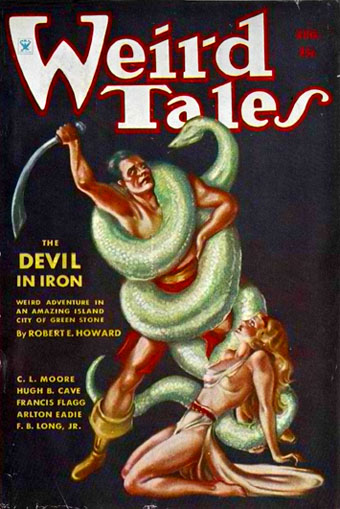
Conan by Margaret Brundage, Weird Tales, August 1934.
Twentieth century art has little room for the figures of myth and legend so it’s been left to genre fiction and the pulps to continue these themes. Margaret Brundage painted many covers for Weird Tales during the magazine’s peak in the Thirties but she was never very good with representations of men. Her depiction of Robert E Howard’s Conan the Barbarian looks rather insipid next to the work of later Conan illustrators such as Roy Krenkel.
Hercules by George Quaintance (1957).
And so the erotic dimension declares itself at last with the work of one of the classic beefcake artists. Quaintance manages to combine elements of the Bosio and Leighton statues while placing them in the context of overtly gay erotica.
Chained by Frank Frazetta; cover to Conan the Usurper by Robert E Howard (1967).
No one ever called Frank Frazetta gay unless they wanted to risk a punch in the mouth. Frazetta is probably the snake attack artist par excellence. He’s also the definitive painter of Conan and the picture above was used on the cover of one of the Lancer reprints which introduced Robert E Howard’s books to a new generation of readers in the late Sixties.
Serpent by Frank Frazetta; cover to Ardor on Argos by Andrew Offutt (1973).
And still they come. This recent (1991) adventure concerning Lester Dent’s pulp hero was painted by Joe DeVito. Bringing things (almost) full circle, the artist has also created a bronze statue based on his picture which looks remarkably like Leighton’s struggling athlete.
Elsewhere on { feuilleton }
• The gay artists archive
Previously on { feuilleton }
• My pastiches
• Fantastic art from Pan Books
• Philip Core and George Quaintance
• The Masks of Medusa
• The art of Giulio Aristide Sartorio, 1860–1932

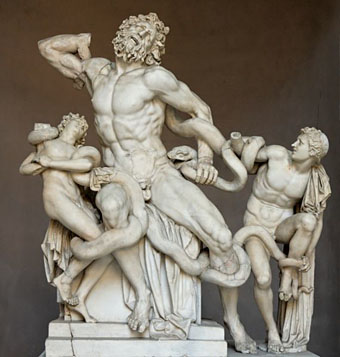
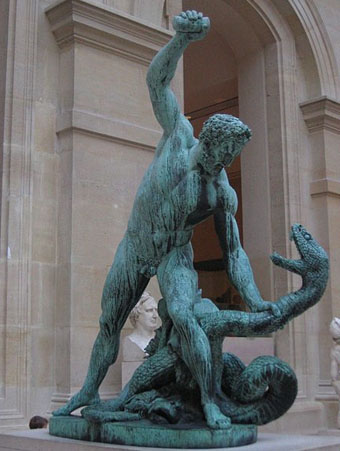
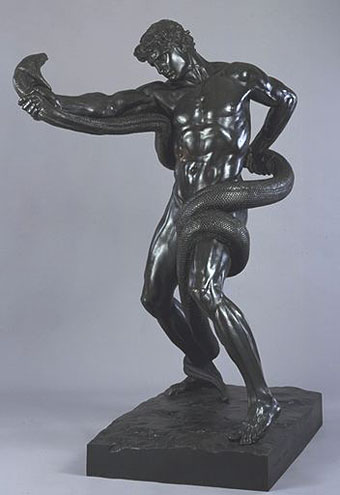
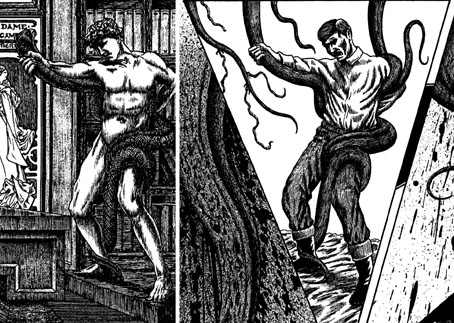
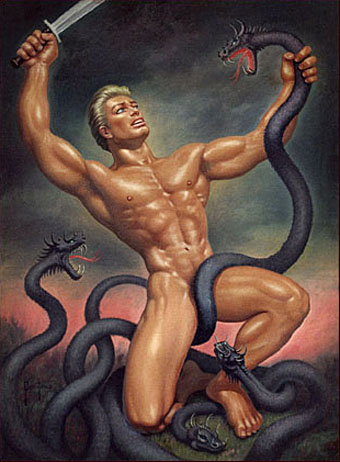
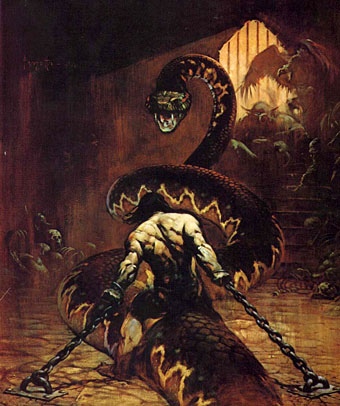
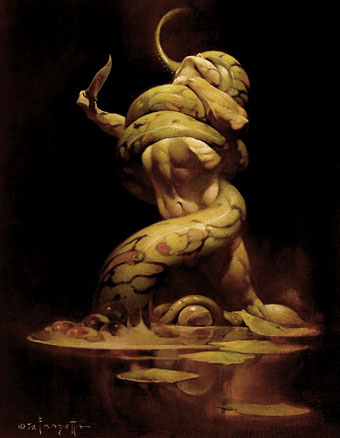
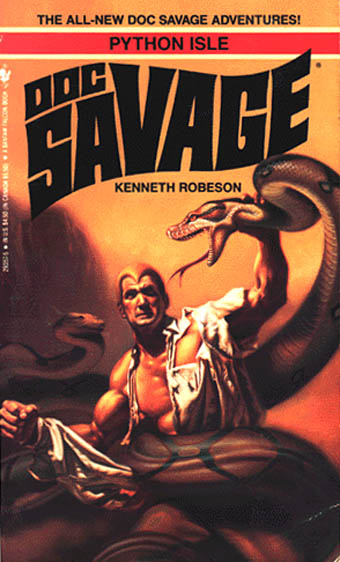
Next time you come to Rome, and if you have not already been there, do not miss a visit to Centrale Montemartini. First the settings are incredible because the old statues are set againt the old electric plant machinery and – second – some of pieces are well worth the trip.
Like this youth fighting a snake. Most of the snake has gone missing but the young man in distress is eye candy.
Ha, that’s a surprising place–ancient statues in a power station. That statue looks like it may well be another Laocoön-inspired piece. The Romans owned it for years, it was presumed to have belonged to Nero at one point, and much of their statuary was an attempt to capture the power of Greek art.
That’s a good tip, thanks. I know there’s other examples of this theme in art until you get to pulp illustrations. I’m sure I’ve seen a few more minor sculptures but I forget the artists’ names.
HA! I was just searching for Weird Tales, and your post is the first that shows up on Google images! That’s sort of a weird tale right there!
I think that’s Google’s ranking process at work; the more links you have, the more you show up at the top of searches.